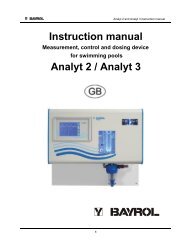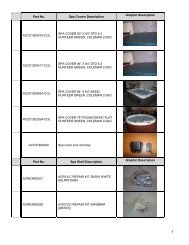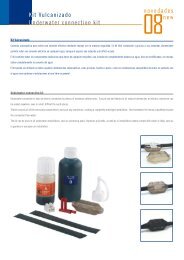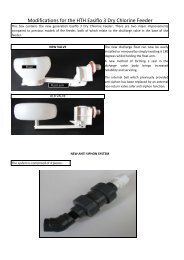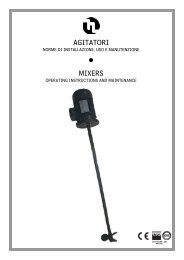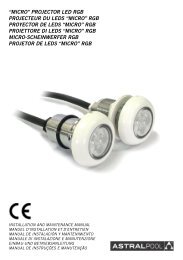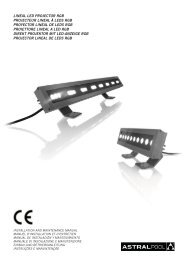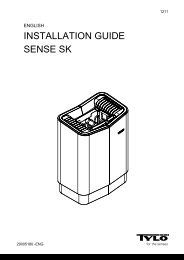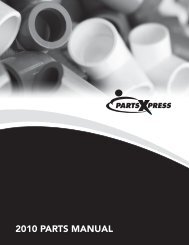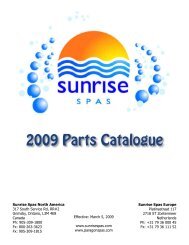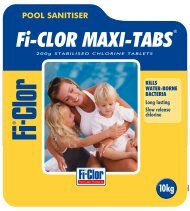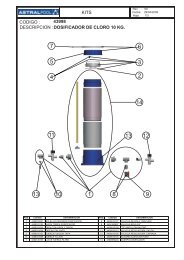palintest 9 Manual - PoolAndSpaCentre
palintest 9 Manual - PoolAndSpaCentre
palintest 9 Manual - PoolAndSpaCentre
Create successful ePaper yourself
Turn your PDF publications into a flip-book with our unique Google optimized e-Paper software.
® POOL.INST.41<br />
INSTRUMENTS<br />
_______________________________________________________________________________________<br />
Pooltest<br />
Professional Plus<br />
TEST INSTRUCTIONS<br />
9<br />
FOR USE WITH PALINTEST POOLTEST 9 SERIES PHOTOMETERS<br />
Palintest Pooltest 9 Professional Plus series photometers are precision colorimeter<br />
instruments specially developed for testing swimming pool water. These instructions<br />
give the procedures for the tests included on your photometer and will help you get<br />
the best results from the instrument.<br />
GETTING THE BEST RESULTS<br />
To get the best results from the photometer follow these simple guidelines :-<br />
1 Carefully read the instructions for using the photometer and understand the<br />
operation of the instrument.<br />
2 Read the test instructions carefully and carry out the procedures precisely as<br />
instructed.<br />
3 Add the tablets to the sample in the manner described in the instructions. Crush<br />
or allow to disintegrate as indicated. Use a separate crushing rod for each tube.<br />
Do not shake the test tubes in order to dissolve the tablets.<br />
4 Place cap on the test tube when the tablets have dissolved before taking<br />
test reading. For most tests, it does not matter if a few small undissolved particles<br />
remain, provided these have settled to the bottom of the tube.<br />
5 Before taking photometer readings ensure that the outside of the tube is clean and<br />
dry. Use a tissue if necessary to wipe off any water drips or condensation.<br />
6 Wash test tubes, caps and crushing rods thoroughly under a running tap after use.<br />
Brush off any stains or deposits. Dry on a clean cloth or rinse with deionised water<br />
before re-use.<br />
7 Replace any test tubes which become scratched or permanently stained.<br />
8 Use the light cap when working out of doors in strong sunlight.<br />
SP 790
SAMPLE COLLECTION<br />
Take pool water samples from below the water surface. Collect in a clean plastic bottle<br />
and fill to the neck so as to avoid unnecessary airspace.<br />
The free chlorine, bromine or ozone levels may drop during sample storage. Other<br />
parameters such as pH and alkalinity can also change. Samples should therefore be<br />
tested as soon as possible after sample collection.<br />
DILUTING THE POOL WATER SAMPLE<br />
When the test result is outside the concentration range of the test, the photometer will<br />
display the > > symbol. In such cases, it is necessary to dilute the pool water and<br />
repeat the test. If the result is close to the top of the scale (eg chlorine above 4 mg/l on<br />
Chlorine-Free/5 or Chlorine-Total/5 range, calcium hardness above 300 mg/l or cyanuric<br />
acid above 150 mg/l) and a more accurate result is required, a dilution may be used to<br />
increase the sensitivity of the test :-<br />
1 Take a Dilution Tube (PT 512) and fill to the x2 mark with pool water. Make-up to<br />
the ‘Deionised Water’ mark with deionised water. Replace the tube cap and mix.<br />
2 Carry out the test on the diluted sample in a 10 ml test tube as per the normal test<br />
instructions.<br />
3 Take the photometer reading in the normal manner.<br />
4 Multiply the test result display be x2 to find the concentration in the original pool<br />
water sample.<br />
Samples may be diluted to a greater extent if necessary. Use the dilution factor appropriate<br />
to the dilution used. Note that it is not possible to dilute samples in the pH test, or when<br />
working in transmittance.<br />
Note the Chlorine/10 range may be used with the appropriate DPD-XF and DPD-XT<br />
tablets to avoid sample dilution.<br />
TEST INSTRUCTIONS<br />
Two ranges are available for free and total chlorine testing:<br />
0 – 5 ppm with traditional DPD No 1 and DPD No 3 tablets<br />
OR<br />
0 – 10 ppm with new DPD-XF and DPD-XT tablets.<br />
Use the SYSTEM MODE to select the range required. Once selected, the<br />
instrument will recall the range selection each time it is used.
Test 1 FREE CHLORINE<br />
Option 1: Range 0 - 5.00 mg/l (ppm) Colourless - Red<br />
1 Rinse test tube with sample leaving two or three drops in the tube.<br />
2 Add one DPD No 1 tablet, crush tablet and then fill the test tube with sample to<br />
the 10 ml mark. Mix to dissolve tablet and ensure any remaining particles have settled.<br />
3 Take photometer reading immediately, as result may drift on standing. Ensure<br />
display shows the Chlorine-Free/5 test is selected.<br />
4 Retain test solution if Total Chlorine test required.<br />
Test 1 FREE CHLORINE<br />
Option 2: Range 0 - 10.0 mg/l (ppm) Colourless - Red<br />
1 Rinse test tube with sample leaving two or three drops in the tube.<br />
2 Add one DPD-XF tablet, crush tablet and then fill the test tube with sample to<br />
the 10 ml mark. Mix to dissolve tablet and ensure any remaining particles have settled.<br />
3 Take photometer reading immediately, as result may drift on standing. Ensure the<br />
display shows the Chlorine-Free/10 test is selected.<br />
4 Retain test solution if Total Chlorine test required.<br />
Test 2 TOTAL CHLORINE<br />
Option 1: Range 0 - 5.00 mg/l (ppm) Colourless - Red<br />
1 Carry out this test on the solution remaining from the Free Chlorine test.<br />
2 If any shock treatment chemicals have been added to the pool, add one DPD Oxystop<br />
tablet, crush and mix to dissolve. This will prevent a response caused by the shock<br />
treatment chemicals.<br />
3 Add one DPD No 3 tablet, crush and mix to dissolve.<br />
4 Stand for two minutes.<br />
5 Take photometer reading. Ensure the display shows Chlorine-Total/5 test is selected.<br />
Test 2 TOTAL CHLORINE<br />
Option 2: Range 0 - 10.0 mg/l (ppm) Colourless - Red<br />
1 Carry out this test on the solution remaining from the Free Chlorine test.<br />
2 If any shock treatment chemicals have been added to the pool, add one DPD Oxystop<br />
tablet, crush and mix to dissolve. This will prevent a response caused by the shock<br />
treatment chemicals.<br />
3 Add one DPD-XT tablet, crush and mix to dissolve.<br />
4 Stand for two minutes.<br />
5 Take photometer reading. Ensure display shows the Chlorine-Total/10 test is selected.<br />
To obtain COMBINED CHLORINE residual subtract Free Chlorine result from Total<br />
Chlorine result :-<br />
ie Combined Chlorine = Total Chlorine - Free Chlorine
Test 3 BROMINE<br />
Range 0 - 10.00 mg/l (ppm) Colourless - Red<br />
1 Rinse test tube with sample leaving two to three drops in the tube.<br />
2 Add one DPD No1 tablet, crush tablet and then fill the test tube with sample to the<br />
10 ml mark. Mix to dissolve tablet and ensure any remaining particles have settled.<br />
3 Take photometer reading immediately, as result may drift on standing.<br />
Test 4 OZONE<br />
Range 0 - 2.00 mg/l (ppm) Colourless - Red<br />
1 Rinse test tube with sample leaving two to three drops in the tube.<br />
2 Add one DPD No 4 tablet, crush tablet and then fill the test tube with sample to the<br />
10 ml mark. Mix to dissolve tablet and ensure any remaining particles have settled.<br />
3 Take photometer reading immediately.<br />
The ozone test also responds to chlorine and bromine. Pools using 'ozone with<br />
chlorine' treatment systems, or other combined treatments, require a special testing<br />
procedure. See separate leaflet.<br />
Test 5 COPPER<br />
Range 0 - 5.00 mg/l (ppm) Colourless - Purple<br />
FREE COPPER<br />
Use this test for pools treated by copper/silver ion generators or treated with<br />
uncomplexed forms of copper such as copper sulphate.<br />
1 Fill test tube with sample to the 10 ml mark.<br />
2 Add one COPPERCOL No 1 tablet, crush and mix to dissolve.<br />
3 Take photometer reading.<br />
TOTAL COPPER<br />
Use this test for pools treated with chelated or complexed forms of copper. Typically<br />
these compounds are used as algicides or winterising treatments.<br />
1 Fill test tube with sample to the 10 ml mark.<br />
2 Add one COPPERCOL No 1 tablet and one COPPERCOL No 2 tablet, crush and<br />
mix to dissolve.<br />
3 Take photometer reading.
Test 6 pH VALUE<br />
Range 6.8 - 8.4 Yellow - Red<br />
1 Fill test tube with sample to the 10 ml mark.<br />
2 Add one PHENOL RED tablet, crush and mix to dissolve.<br />
3 Take photometer reading.<br />
Test 7 ALKALINITY<br />
Range 0 - 500 mg/l (ppm) Yellow - Green - Blue<br />
1 Fill test tube with sample to the 10ml mark.<br />
2 Add one ALKAPHOT tablet, crush thoroughly and mix. Ensure all of the particles<br />
have dissolved completely.<br />
3 Allow to stand for one minute.<br />
4 Take photometer reading.<br />
Test 8 CALCIUM HARDNESS<br />
Range 0 - 500 mg/l (ppm) Violet - Orange<br />
Use Test 8 for fresh water swimming pools. Press key twice within two seconds to<br />
access Test 88 for saltwater pools.<br />
1 Fill test tube with sample to the 10 ml mark.<br />
2 Add one CALCICOL No 1 tablet, crush and mix to dissolve.<br />
3 Add one CALCICOL No 2 tablet, crush and mix to dissolve.<br />
4 Stand for two minutes.<br />
5 Take photometer reading.<br />
Test 9 CYANURIC ACID<br />
Range 0 - 200 mg/l (ppm) Clear - Cloudy<br />
Use this test for chlorine-treated pools stabilized with cyanuric acid or using 'stabilised<br />
chlorine' donors. Cyanuric acid is commonly referred to as 'Chlorine Stabiliser' or 'Pool<br />
Conditioner'.<br />
1 Fill test tube with sample to the 10 ml mark.<br />
2 Add one CYANURIC ACID tablet and allow to disintegrate for at least two minutes.<br />
A cloudy solution indicates the presence of cyanuric acid.<br />
3 Crush any remaining undissolved tablet, mix and then take photometer reading. Use<br />
the light cap whilst blanking and taking reading.<br />
It is recommended that the light cap is used when carrying out this test under strong or<br />
variable lighting conditions.
Test 77 WATER BALANCE<br />
To determine Water Balance Index using the Pooltest 9 Professional Plus, three tests<br />
must be prepared and read using the Water balance test program :<br />
Alkalinity (Alkaphot), Calcium Hardness (Calcicol) and pH (Phenol Red) tests are<br />
required. Prepare the test solutions and proceed as follows :-<br />
1 Select Test 77 by pressing Alkalinity key twice.<br />
2 Carry out alkalinity test then select ‘Follow on’ from the OPTIONS menu at the<br />
results screen.<br />
3 Carry out the calcium hardness test then select ‘Follow-on’ from the OPTIONS<br />
menu at the results screen.<br />
4 Carry out the pH test then select ‘Follow-on’ from the OPTIONS menu at the results<br />
screen.<br />
5 The Water Balance Index is calculated and is displayed. Consult the chart below for<br />
guidance.<br />
NOTE: If any of the tests are out of range, the procedure is ended. If an incorrect reading<br />
is taken part-way through the procedure, insert the correct tube then select ‘Read’ from the<br />
OPTIONS menu. The new reading will replace the former incorrect value in the Water<br />
Balance Calculation:<br />
Index<br />
Below 9.6<br />
Water Balance<br />
Condition<br />
Highly Corrosive<br />
9.6 to 10.5 Corrosive<br />
Recommendation<br />
Increase pH to 7.5 - 7.8.<br />
Increase Calcium Hardness to at least<br />
50 mg/l.<br />
Increase Total Alkalinity to 100 mg/l<br />
or higher as necessary.<br />
Retest Water Balance.<br />
10.6 to 10.9 Acceptable Balance Retest water regularly.<br />
11.0 to 11.2 Ideal Balance No action required.<br />
11. 3 to 11.6 Acceptable Balance Retest water regularly.<br />
11. 7 to 12.6 Scale Forming<br />
Above 12.6<br />
Highly Scale Forming<br />
Decrease pH to 7.2 - 7.5.<br />
Decrease Total Alkalinity to 150 mg/l or<br />
lower as necessary.<br />
Retest Water Balance.<br />
NOTES<br />
1 The test has been calculated for an average heated swimming pool (82°F, 28°C).<br />
For unheated swimming pools, subtract 0.1 from the index value obtained, for high<br />
temperature pools and spas, add 0.1 to the index value obtained.<br />
2 Always keep the pH, Total Alkalinity and Calcium Hardness levels within the limits<br />
recommended in pool operating instructions and chemical suppliers' recommendations.<br />
Seek specialist advice if corrosion or scale formation is still apparent even though<br />
the water is shown to be in a balanced condition.
REORDER CODES FOR REPLACEMENT REAGENTS<br />
Replacement reagents for each of the tests are available under the following product<br />
codes - packs contain sufficient tablets for 250 tests :-<br />
AP 011<br />
AP 031<br />
AP 013<br />
AP 033<br />
AP 060<br />
AP 056<br />
AP 187<br />
AP 186<br />
AP 130<br />
AP 188<br />
AP 252<br />
AP 087<br />
Free Chlorine<br />
Free, Combined and Total Chlorine<br />
Free Chlorine (DPD-XF)<br />
Free, Combined and Total Chlorine (DPD-XF and DPD-XT)<br />
Bromine<br />
Ozone<br />
Free Copper<br />
Free and Total Copper<br />
pH (Phenol Red)<br />
Alkalinity (Alkaphot)<br />
Calcium Hardness (Calcicol)<br />
Cyanuric Acid<br />
PT 595/5 Replacement Photometer Test Tubes (Pack of 5)<br />
V3-04/08



